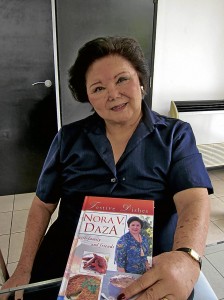
“We need to establish Filipino restaurants abroad,” observers note. “In major cities there is always a Chinese, Indian, French, Japanese restaurant—but no Filipino restaurants!”
“Filipino food is porky at best,” New York Times critic Seth Mydans once said. “It’s brown food,” another critic said insultingly.
Patriotic foodies wonder when we will finally make Filipino food part of the centripetal force of foreign cuisines in major cities.
But in fact, it has been done. As early as 1965, living culinary legend Nora Daza had established Aux Iles Philippines (The Philippine Islands) in Paris. And in 1974, she opened Maharlika, the first Filipino high-end restaurant in New York City.
Three forks
Aux Iles Philippines became one of the top three Asian restaurants in Paris and was given no less than three forks by the Guide Michelin. Then Maharlika was awarded four crowns by Pan America.
It wasn’t an easy ride. “New Yorkers were shocked at the way we cooked our meals,” Daza said. “For example, we would serve fish whole, including the head. They weren’t used to this kind of presentation because they are used to fillet.”
Meanwhile, Filipinos found the menu, with steaks at $1.50, too expensive. It was a difficult balance. Nevertheless, the restaurant lasted four years.
Paris was easier. In spite of the language barrier, authentic Filipino dishes like fresh lumpia were a hit, patronized by no less than top celebrities such as Bridgit Bardot.
Fond memories abound: flying in kuhol from Bicol and amazing French escargot-lovers; and entrancing Parisians with the refreshing sourness of sinigang na sugpo.
Aux Iles Philippines eventually had to retire, but it made its point, as summed up by Nora Daza’s son, food show host, columnist and chef Sandy Daza: “People now debate how to bring Filipino food to the world stage. It’s been done. My mom did it.” ‘Nuff said.
Exchange programs
And it wasn’t just through restaurants, either. Daza capitalized on the value of exchange programs to both educate Filipinos on worldly flavors and likewise to bring Philippine flavors to the rest of the world.
Aside from the many foreign chefs she brought to the Philippines, including Paul Bocuse, she also brought aspiring Filipino chefs abroad.
In 1988 she brought winners of the Great Maya Cookfest to the United States where, as head of the delegation, she explained in an interview with the LA Times: “Their goal is to share Filipino cuisine and enrich their knowledge of the culinary arts of other lands.” Truly she was the first Philippine culinary ambassador.
Pleasures all around
At 83, she no longer cooks but guides those who dare cook her recipes before her.
“I always tell my cook, do not put too much salt because if there’s too much salt you have to put water and it will dilute the flavors. You can always add salt but you cannot take it out.” Thankfully, her children have inherited both her talent and love for cooking.
She is very proud of daughter Nina as well as son Bong Daza’s previous hit Bahay Batchoy on Pasay Road, and of son Sandy’s current restaurant Wooden Spoon. “He is very meticulous when it comes to cooking,” Daza says of Sandy, and notes that the recipes at Wooden Spoon are his own.
And for the rest of us, there are her many books. She started writing recipes in 1965 for her first book, “Let’s Cook With Nora,” and shares with utmost candor: “People would always ask me to cook for them. And it was becoming expensive because I would have to buy ingredients. So I thought, why not just write it all down in a book?”
Her latest, “Festive Dishes,” shares not only her own recipes but also those from relatives and friends from all over the world. Released in July 2011, it’s now on its second print.
So while we will never get to taste creations from her 1965 French resto Au Bon Vivant, such as the legendary Chateaubriand with Bernaise sauce—at least we will be able to attempt to resurrect it on our own via Nora Daza’s books.
“I think the important thing about cooking is the pleasure you give to somebody else,” she shared. Daza has put a smile on many, many faces, indeed.
P.S. Speaking of legends, a tribute to Inquirer food critic and world-renowned food anthropologist and author Doreen G. Fernandez is ongoing at the De la Salle University’s Yuchengco Museum. Do visit!